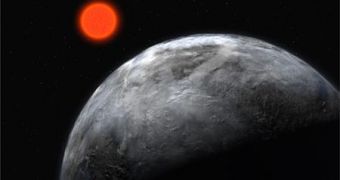Similar to our Moon, which always shows the same face towards Earth, some rocky planets might also present this particularity, meaning that half of their surface is extremely hot while the other half might be ice cold. Studies show that if they have long orbits around their Sun, they could have increased chances of housing life at the borderline between the two extreme zones.
Such extrasolar planets having half frozen half scorched surfaces could create areas with large twilights that might have temperatures in the ranges suitable for life. Theories modeling gravitational interactions between rocky bodies and the objects they orbit reveal that the 'tidal lock' phenomena occurs relatively often, as the object settles into an orbit trajectory. Common sense usually points that such rocky bodies would generally be unsuitable for life, since they only face one hemisphere towards the star roasting its surface, while the other half falls into a Deep Freeze.
However, computer simulations made at NASA's Ames Research Center in California by Anthony Dobrovolskis reveal that this might not always be the case and he found evidence that such planets oscillating back and forth as they travel on their elongated orbit around the star create twilight zones suitable for life to appear.
The 'tidal lock' situation is generated when the rotation of the orbiting object equals the speed of the object's orbital trajectory, thus triggering a phenomena in which it only shows one face toward the object it orbits. Nevertheless, no object ever follows a perfectly circular path, thus causing it to rock slightly. The same applies to our Moon.
Planets exhibiting very elongated orbits will experience an accentuated rocking motion that could determine a more temperate clime on that respective body than previously thought. According to Dobrovolskis, planets exhibiting a rocking motion of 90 degrees or more relative to the object they orbit do not display permanent day or night sides, but rather the whole object becomes a twilight zone.
The possibility of presence of life on bodies in the proximity of red dwarfs greatly increased due to the fact that the habitable zone of the dwarf star is relatively close to the star and any planet orbiting that region would most likely be tidally locked to the star.
However, Dobrovolskis says that though this theory presents new perspectives in the search for life in extremely inhospitable locations the astronomers should still concentrate on objects with relatively even temperatures across their surface.

 14 DAY TRIAL //
14 DAY TRIAL // 
